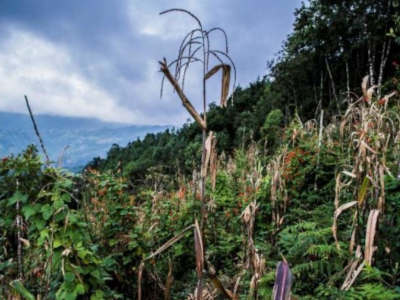By Mike Listman
The traditional milpa intercrop in which maize is grown together with beans, squash or other vegetable crops can provide food and nutrients for marginalized, resource-poor communities in the Americas, according to a study published last week in Nature Scientific Reports.
One hectare of a milpa comprising maize, common beans and potatoes can provide the annual carbohydrate needs of more than 13 adults, enough protein for nearly 10 adults, and adequate supplies of many vitamins and minerals, according to the study. The research was based on data from nearly 1,000 households across 59 villages of the Western Highlands of Guatemala and is the first to relate milpa intercropping diversity with nutritional capacity, using multiple plots and crop combinations.
"The milpa was the backbone of pre-Columbian agriculture in North America, Mexico, and Central America," said Santiago López-Ridaura, specialist in agricultural systems and climate change adaptation at the International Maize and Wheat Improvement Center (CIMMYT) and lead author of the article.
"Milpa production anchored around locally adapted maize is still an essential food and nutritional lifeline for isolated, often indigenous communities throughout Mexico and Central America, and can be tailored to improve their food and nutritional security, along with that of small-scale farmers in similar settings," he added.
Maize for feed or food and nutrition?
In modern times, some 1 billion tons of maize are harvested yearly from about 200 million hectares worldwide. Much of this output results from intensive monocropping of hybrids that yield an average 10 tons per hectare in places like the U.S.
This massive world harvest goes chiefly for animal feed, corn starch, corn syrup, ethanol and myriad industrial products, but in sub-Saharan Africa, Latin America, and parts of Asia, maize remains a critical food staple, often grown by smallholder farmers with yields averaging around 1.5 tons per hectare.
The Western Highlands of Guatemala is among the world's poorest regions—a mountainous area ill-served by markets and where communities battered by food insecurity and malnutrition sow crops at altitudes of up to 3,200 meters, according to Cristian A. Reyna-Ramírez, a co-author of the study from the Universidad Autónoma Metropolitana-Xochimilco, Mexico.
"Fully two-thirds of farmers in this region grow milpas based on maize but varying the intercrops with potatoes, faba beans and even fruit trees," Reyna-Ramírez said. "Our study showed that combinations such as maize-common bean-faba bean, maize-potatoes, and maize-common bean-potatoes provided the most carbohydrates, proteins, zinc, iron, calcium, potassium, folate, thiamin, riboflavin, vitamin B6, niacin and vitamin C."

The classic “milpa” intercrop comprises maize, beans, and squash. The bean plant climbs the maize stalk to reach sunlight and its roots add nitrogen to the soil; the squash leaves shade the soil, conserving moisture and inhibiting weed growth. Milpa systems are often grown on steep hillsides at a wide range of altitudes.
Better diets and routes out of poverty?
With typical landholdings of less than a quarter hectare and households averaging six members, Guatemala's Western Highlands inhabitants cannot depend on the milpa alone to satisfy their needs, López-Ridaura cautioned.
"As with many smallholder farm communities, lack of land and general marginalization traps them in a vicious circle of poverty and malnutrition, forcing them to experiment with risky cash crops or for working-age members to undertake dangerous and heartbreaking migrations to find work and send back remittances," he explains.
According to López-Ridaura, this study points the way for tailoring milpa systems to help communities that still rely on that intercrop or others that could benefit from its use.
Click here to see more...